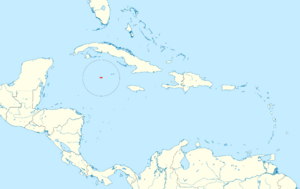Grand Cayman thrush facts for kids
Quick facts for kids Grand Cayman thrush |
|
|---|---|
| Conservation status | |
| Scientific classification | |
| Genus: |
Turdus
|
| Species: |
ravidus
|
 |
|
| Synonyms | |
|
|
The Grand Cayman thrush (Turdus ravidus) was a special bird that used to live only on the island of Grand Cayman. This island is in the Caribbean Sea. Sadly, this bird is now extinct, meaning there are no more Grand Cayman thrushes left in the world. It belonged to the thrush family.
What It Looked Like
The Grand Cayman thrush was mostly a grey bird, like the color of ash. Its belly was white. The feathers under its tail and the tips of its outer tail feathers were also white.
This bird had bright red skin around its eyes. Its bill (beak) and feet were also red. Its wings were about 13.5 centimeters long. Its tail was about 11 centimeters long. The bill was about 2.4 centimeters long, and its legs were around 3.8 centimeters long.
Where It Lived
This thrush lived in the northern and northeastern parts of Grand Cayman. Its home was in swampy areas and places with mangrove trees. Some of these areas had manchineel trees (Hippomane mancinella), which are known to be poisonous. It also lived in rocky areas with sharp coral and a climbing plant called the climbing cactus (Epiphyllum hookeri).
Why It Disappeared
When Charles B. Cory first described the Grand Cayman thrush in 1886, he said it was common. However, soon after it was discovered, people started collecting these birds. Over time, 21 specimens were collected by bird collectors.
The last time someone reliably saw a living Grand Cayman thrush was in the summer of 1938. A zoologist named C. Bernard Lewis saw one bird north of East End, in the eastern part of Grand Cayman. After this, the bird was never seen again.
The main reasons the Grand Cayman thrush likely went extinct were:
- Losing its home: deforestation (when forests are cut down) destroyed its habitat.
- Strong storms: Powerful hurricanes that hit the island between 1932 and 1944 also damaged its living areas.
Today, you can see stuffed specimens of the Grand Cayman thrush in several museums around the world. For example, some are in the Field Museum of Natural History in Chicago and the Natural History Museum in London.


